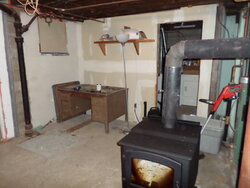Hello all,
Had a fire in the new Englander 30 when it got down to 35 a few nights ago. Stove is in the basement, in the middle of the house. Basement is 24x36. Upstairs is roughly the same with a small sun room attachment. Have a small 6in x 10in grate in the floor above the stove, but will probably end up leaving the basement door open as well (happens to be right next to the grate). My main question is do you think an OAK will work in this case? You can see my situation in the picture. I would install the outside air through that old window on the left, which is currently sheetrock on the inside and plywood on the outside. It's about 11.5ft in a straight line from the stove to the wall, but what I would do is use dryer duct, run it vertically to the ceiling, then across the plumbing to the wall, which is well above grade and under a deck, which would protect it from the elements. Would an air intake setup like that even be worth it?

Had a fire in the new Englander 30 when it got down to 35 a few nights ago. Stove is in the basement, in the middle of the house. Basement is 24x36. Upstairs is roughly the same with a small sun room attachment. Have a small 6in x 10in grate in the floor above the stove, but will probably end up leaving the basement door open as well (happens to be right next to the grate). My main question is do you think an OAK will work in this case? You can see my situation in the picture. I would install the outside air through that old window on the left, which is currently sheetrock on the inside and plywood on the outside. It's about 11.5ft in a straight line from the stove to the wall, but what I would do is use dryer duct, run it vertically to the ceiling, then across the plumbing to the wall, which is well above grade and under a deck, which would protect it from the elements. Would an air intake setup like that even be worth it?


